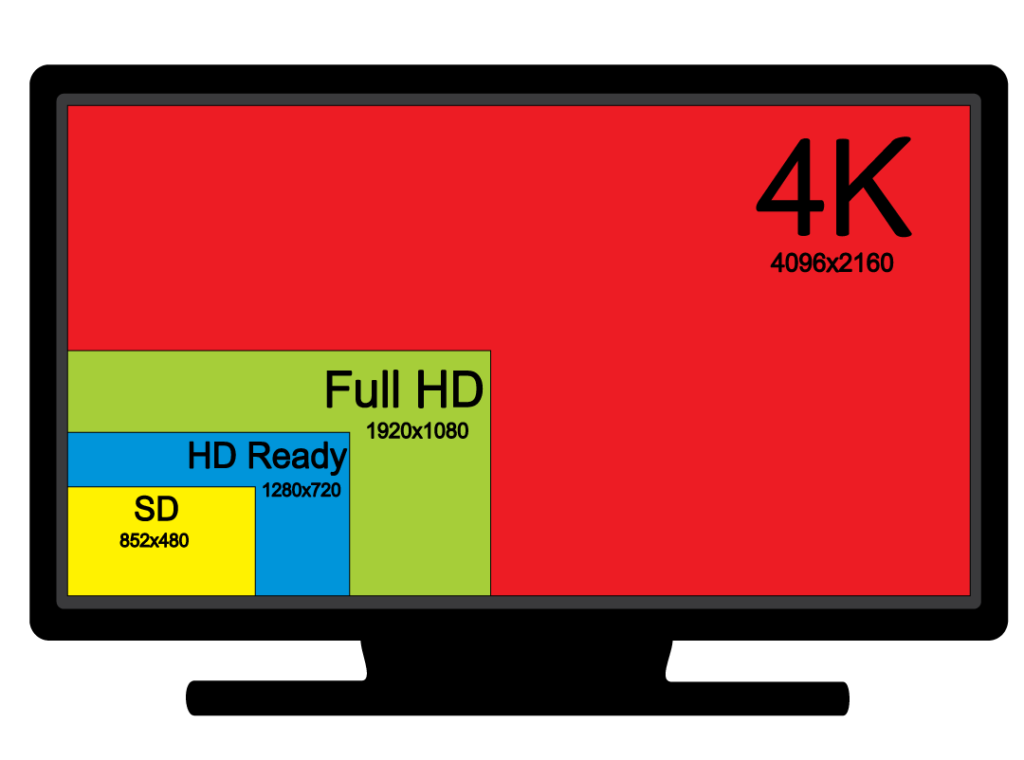4K resolution is a term that refers to a horizontal display resolution of approximately 4,000 pixels. If you are looking for a new TV, monitor, or projector, you might have come across the term 4K. But what does it mean and how does it affect your viewing experience? In this article, we will explain what 4K is, how it differs from other resolutions, and what benefits it offers.

What is 4K resolution?
4K resolution is a term used to describe a display resolution with approximately 4,000 horizontal pixels. It is also known as Ultra HD (UHD) or 2160p, depending on the context. There are several different 4K standards used in different industries, such as digital cinema, television, and consumer media. The most common ones are:
- 4K UHD: This is the dominant 4K standard for television and consumer media. It has a resolution of 3840 x 2160 pixels, which is four times the resolution of Full HD (1080p). It has an aspect ratio of 16:9, which means that the width of the screen is 16 units and the height is 9 units. This is the same aspect ratio as most HD TVs and monitors.
- DCI 4K: This is the standard for digital cinema projection. It has a resolution of 4096 x 2160 pixels, which is slightly wider than 4K UHD. It has an aspect ratio of approximately 1.9:1, which means that the width of the screen is about 1.9 times the height. This is similar to the aspect ratio of some widescreen movies.

How Does 4K Resolution Compare to other Resolutions?
To understand how 4K compares to other resolutions, we need to look at the number of pixels and the pixel density. Pixels are the tiny dots that make up an image on a screen. The more pixels there are, the more detail and clarity the image can have. Pixel density is the number of pixels per inch (ppi) on a screen. The higher the pixel density, the sharper and smoother the image can appear.
Let’s take a look at some common resolutions and their pixel counts and pixel densities:
- SD (Standard Definition): This is the lowest resolution that is still widely used today. It has a resolution of 720 x 480 pixels for NTSC (North America) or 720 x 576 pixels for PAL (Europe). It has an aspect ratio of either 4:3 or 16:9, depending on the format. It has a pixel density of about 36 ppi for a typical 32-inch TV.
- HD (High Definition): This is the most common resolution for TV broadcasts and streaming services today. It has a resolution of either 1280 x 720 pixels (720p) or 1920 x 1080 pixels (1080p). It has an aspect ratio of 16:9. It has a pixel density of about 69 ppi for a typical 32-inch TV or about 44 ppi for a typical 50-inch TV.
- Full HD: This is another name for 1080p resolution. It has a resolution of 1920 x 1080 pixels and an aspect ratio of 16:9. It has a pixel density of about 44 ppi for a typical 50-inch TV or about 27 ppi for a typical 80-inch TV.
- 4K UHD: This is the dominant 4K standard for TV and consumer media. It has a resolution of 3840 x 2160 pixels and an aspect ratio of 16:9. It has a pixel density of about 88 ppi for a typical 50-inch TV or about 55 ppi for a typical 80-inch TV.
- DCI 4K: This is the standard for digital cinema projection. It has a resolution of 4096 x 2160 pixels and an aspect ratio of approximately 1.9:1. It has a pixel density of about 92 ppi for a typical 50-inch TV or about 58 ppi for a typical 80-inch TV.
As you can see, 4K resolution offers significantly more pixels and higher pixel density than other resolutions, which means that it can deliver more detail, clarity, and realism to your screen.
What are the Benefits of 4K Resolution?
There are many benefits to watching content in 4K resolution, such as:
- Enhanced picture quality: With four times more pixels than Full HD, 4K resolution can produce sharper, clearer, and more lifelike images. You can see more details, textures, colors, and contrasts in your favorite movies, shows, games, and photos.
- Immersive viewing experience: With higher pixel density, 4K resolution can create smoother and more seamless images that fill your field of vision. You can enjoy a more cinematic and realistic experience, especially on larger screens or closer viewing distances.
- Future-proof technology: With more and more content being produced and distributed in 4K resolution, you can be ready for the next generation of entertainment. You can access a growing library of 4K content from various sources, such as streaming services, Blu-ray discs, gaming consoles, cameras, and smartphones.
What do you Need to Watch 4K Content?
To watch content in 4K resolution, you need:
- A 4K TV, monitor, or projector: This is the most obvious requirement. You need a device that can display 4K resolution. There are many models and brands to choose from, depending on your budget, preferences, and needs. You can also look for features such as HDR, OLED, or QLED that can enhance the quality of 4K images.
- A 4K source: This is the device or service that provides 4K content. You need a source that can output 4K resolution and that is compatible with your display device. Some examples of 4K sources are:
- Streaming services: Many online platforms offer 4K content, such as Netflix, Amazon Prime Video, YouTube, Disney+, and Apple TV+. You need a fast and stable internet connection to stream 4K content without buffering or lagging. You may also need to pay extra for a premium subscription that includes 4K access.
- Blu-ray players: You can play 4K Blu-ray discs on a compatible player that supports the Ultra HD Blu-ray format. You can enjoy the highest quality of 4K content with uncompressed audio and video. You need an HDMI cable that supports HDCP 2.2 to connect your player to your display device.
- Gaming consoles: You can play 4K games on a console that supports 4K output, such as the PlayStation 5, Xbox Series X, or Xbox Series S. You can experience more immersive and realistic graphics and gameplay. You need an HDMI cable that supports HDMI 2.1 to connect your console to your display device.
- Cameras and smartphones: You can record or capture 4K videos or photos on a camera or smartphone that supports 4K resolution. You can then play them back on your display device using a cable or wireless connection.
Conclusion
4K resolution is a term that refers to a horizontal display resolution of approximately 4,000 pixels. It offers many benefits for your viewing experience, such as enhanced picture quality, immersive viewing experience, and future-proof technology. To watch content in 4K resolution, you need a 4K display device and a 4K source. If you are looking for a new TV, monitor, or projector, you might want to consider getting one that supports 4K resolution. It will make your entertainment more enjoyable and satisfying.
Some 4K TVs available in Pakistan










